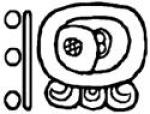 If there was ever a day to expect magical things to happen, it would be 13 Ix. It is a day when the energy of the spirit world is listening, and so prayers made at natural shrines and altars may prove very fruitful.
If there was ever a day to expect magical things to happen, it would be 13 Ix. It is a day when the energy of the spirit world is listening, and so prayers made at natural shrines and altars may prove very fruitful.
The nawal Ix is particularly associated with shrines and altars, and with the energy of the number 13 associated with it suggests ancestral places. This suggests a focus on the ancient sacred places, and it is likely that words spoken at these places may have very strong effects. This day also finishes off the Iq’ trecena, this time of change and possible upheaval. However, Iq’ is also the nawal of communication, and we see here on the final day of the Iq’ trecena, the divine breath put into practice at the ancestral shrines as Ix, the prayer giver, makes the flower words. This is a day to call on the spirits of the ancestors to help us better understand our relationship with Mother Earth.
It is a day to ask the spirit of Mother Earth for that which you require in your life path. Of course when she gives you exactly what you need, it is important to thank her, and this day is an excellent day for demonstrating your gratitude to Mother Earth. This may be through some act of caring for your local area. The manifestation energy today is very strong, it should be noted that the phrase “be careful what you wish for” is particularly applicable.

Ix is possibly the most feminine of the nawales. It represents the spirit of Mother Earth and could easily be seen as a Mayan representation of Gaia. Ix can be seen as a mothering energy, nurturing all things, but this should not be confused with weakness – the animal totem of Ix is the jaguar and it is as the jaguar that Ix is often known. The jaguar is, of course, powerful and stealthy. Ix also embodies these qualities. The jaguar is an animal of the night, slipping magically through the darkness, the spots of her back a representation of the milky way. She carries the sun on it’s nightly journey through the underworld.
Industrialised societies tend to see the Earth as an inanimate source of material wealth. Non-industrialised societies see her as a living entity with whom we can interact, and she carries the nawal Ix. So, it is on Ix days that prayers are offered at her places, the shrines and altars, her ears, to ask for what we need in our world.
The connection Ix has with the Earth gives it the ability to manifest material wealth. In the Mayan cross astrological configuration, Kame evolves to Ix. In the Popol Vuh, the sacred book of the Maya, the Hero Twins sacrificed themselves in the underworld (Kame) and then were resurrected as a pair of catfish, later to become travelling magicians (Ix.) They cut the heads off animals, then resurrected them, they even cut off each others heads and brought each other back to life. In these scenes they are shown with patches of jaguar skin on their clothing, a symbolism denoting that the wearer is a shaman. Thus through the symbolic death or sacrifice, the shamanic power emerges.
Whilst Ix has the power to engage with the magic of the Earth, it also has a tendency towards illness. This is particularly strong when the vain, ungrateful side of Ix emerges. The magic that runs through this nawal comes so easily, that sometimes it forgets that everything really comes from the Earth and it is to the Earth that we must show our gratitude. Ix is also the nawal of natural shrines and altars, the places where fire ceremonies are made to give thanks. A spirit of gratitude and humility keeps Ix healthy. Ix is of course deeply connected with the natural world and it is here that they find their wisdom, power and wealth. This is a day to give thanks, to remember gratitude, and a day to engage with your magic.
The number 13 is the final number. It represents the spirit world. It is said that on Halloween, the veil between the worlds is the thinnest. However within the sacred calendar, this thinning happens every 13 days. This connection with the spirit world creates a powerful day, where both the positive and negative aspects of the nawal it is attached to come through strongly. It is a very good day for activities such as divinations, however, ceremonies on 13 days should only be carried out by the most experienced Aj Q’ij who understand how to work with that strength of energy.






























 The nawal of transformation blends with the number of work, which can give a good impression of the sort of things today may hold in store. Just remember that some changes are more beneficial when they are clearly thought through.
The nawal of transformation blends with the number of work, which can give a good impression of the sort of things today may hold in store. Just remember that some changes are more beneficial when they are clearly thought through.

